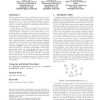Free Online Productivity Tools
i2Speak
i2Symbol
i2OCR
iTex2Img
iWeb2Print
iWeb2Shot
i2Type
iPdf2Split
iPdf2Merge
i2Bopomofo
i2Arabic
i2Style
i2Image
i2PDF
iLatex2Rtf
Sci2ools
SIGMOD
2010
ACM
2010
ACM
Towards proximity pattern mining in large graphs
Mining graph patterns in large networks is critical to a variety of applications such as malware detection and biological module discovery. However, frequent subgraphs are often ine’¼Ćective to capture association existing in these applications, due to the complexity of isomorphism testing and the inelastic pattern de’¼ünition. In this paper, we introduce proximity pattern which is a signi’¼ücant departure from the traditional concept of frequent subgraphs. De’¼üned as a set of labels that co-occur in neighborhoods, proximity pattern blurs the boundary between itemset and structure. It relaxes the rigid structure constraint of frequent subgraphs, while introducing connectivity to frequent itemsets. Therefore, it can bene’¼üt from both: e’¼ācient mining in itemsets and structure proximity from graphs. We developed two models to de’¼üne proximity patterns. The second one, called Normalized Probabilistic Association (NmPA), is able to transform a complex graph mining problem to a simpli’...
| Added | 18 Jul 2010 |
| Updated | 18 Jul 2010 |
| Type | Conference |
| Year | 2010 |
| Where | SIGMOD |
| Authors | Arijit Khan, Xifeng Yan, Kun-Lung Wu |
Comments (0)

